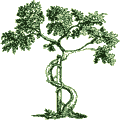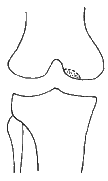
|
|||||||
Osteochondritis Dissecans of the Knee

What is it?
Osteochondritis Dissecans (O.D.) of the knee is a condition where are fragment of bone just below the joint surface loses its blood supply and separates out from the rest of the bone. The commonest site of the lesion is the lateral surface of the medial femoral condyle.
No one knows why a segment of bone should lose its blood supply, although most doctors believe that it is due to repetitive trauma. The most common site of O.D. is also the area of the femur that is often impinged by the tibial spine during active sports. In time, the O.D. fragment may separate itself from the rest of the femur, and becomes detached completely.
What are the symptoms?
O.D. occurs commonly in the older child and adolescent who is active in sports. He presents with pain and locking and the knee "giving way". He has tenderness at the point of the O.D., which is often the lateral surface of the medial femoral condyle.
What does your doctor do about it?
He will perform X-rays which are often diagnostic, especially the intercondylar view (the "notch" view") which brings the O.D. lesion into profile. An MRI is usually not necessary for diagnosis, and is done only if there is any concern about any associated soft tissue injuries.
Treatment in the younger child is usually conservative, especially if the O.D. fragment on X-ray is still attached. A long cylinder cast to protect the O.D. lesion for 6 to 8 weeks often allows healing, and gradual return to sports. In cases where the O.D. lesion has separated out or becomes partially detached, arthroscopic surgery to pin the lesion back in place is necessary. In the most severe cases where the fragment of bone is a loose body in the knee joint, and nonviable, arthroscopic excision is all that can be done. The base of the crater from where the fragment is lost, is freshened by curettage and drilling, in an attempt to stimulate healing and formation of new bone.
NOTICE: The information presented is for your information only, and not a substitute for the medical advice of a qualified physician. Neither the author nor the publisher will be responsible for any harm or injury resulting from interpretations of the materials in this article.
Questions
or comments? Post your thoughts in the Orthoseek
Message Forum!
Find a pediatric orthopedic surgeon
in an area near you.
Home | About Us | Orthopaedic Topics | Message Forum
![]()
Comments, questions, or suggestions are welcome. Please
contact us using this form.